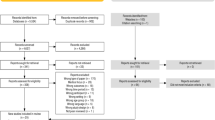Abstract
A significant segment of the population—evangelical Christians—has historically been underrepresented in psychotherapy and in the treatment literature. Consequently, few guidelines for therapeutic decision making and intervention have been articulated. Because the clergy are showing an increasing willingness to refer these people to human service professionals, it is important that clinicians be informed about this group of potential clients. Therapeutic strategies whick take into account the unique characteristics of this population are discussed in light of four stages in the development of the helping relationship.
Similar content being viewed by others
References
American Psychological Association.Casebook on ethical standards of psychologists. Washington, D.C.: Author, 1967.
Beit-Hallahmi, B. Encountering orthodox religion in psychotherapy.Psychotherapy: Theory, Research and Practice, 1975,12, 357–359.
Bonner, A. Psychotherapy with religious patients.American Journal of Psychotherapy, 1964,18, 475–487.
Born again! The year of the evangelicals.Newsweek, October 25, 1976, pp. 68–70; 75–78.
Cialdini, R.B., & Mirels, H.L. Sense of personal control and attributions about yielding and resisting persuasion targets.Journal of Personality and Social Psychology, 1976,33, 395–402.
Counting souls.Time, October 4, 1976, p. 75.
Davison, G.G., & Valins, S. Maintenance of self-attributed behavior change.Journal of Personality and Social Psychology, 1969, 11, 25–33.
Erickson, M. Further techniques of hypnosis: Utilization techniques.American Journal of Clinical Hypnosis, 1959,2, 3–21.
Erickson, M., & Rossi, E. Varieties of double bind.American Journal of Clinical Hypnosis, 1975,17, 143–157.
Farberow, N.L. (Ed.),Taboo topics. New York: Atherton Press, 1963.
Freud, S.The future of an illusion. New York: Liveright Publishing Co., 1928.
Grant, F.An introduction to New Testament thought. Nashville: Abington Press, 1950.
Henry, W.E., Sims, J.H., & Spray, S.L.The fifth profession. San Francisco: Jossey-Bass, 1971.
James, W.The varieties of religious experience. New York: Longmans, Green & Co., 1903.
Joint Commission on Mental Illness and Health.Action for mental health. New York: Basic Books, 1961.
Larsen, J.A. Dysfunction in the evangelical family: Treatment considerations.The Family Coordinator, in press.
Lorand, S. Psychoanalytic therapy of religious devotees.International Journal of Psychoanalysis, 1962,43, 50–56.
McCann, R.V.The churches and mental health. New York: Basic Books, 1962.
Minuchin, S.Families and family therapy. Cambridge, Mass.: Harvard University Press, 1974.
Pruyser, P.W. Assessment of the patient's religious attitudes in the psychiatric case study.Bulletin of the Menninger Clinic, 1971,35, 272–291.
Reiber, S.R. Western Christian conceptual framwork for viewing the family. In F.I. Nye & F.M. Berardo (Eds.)Emerging conceptual frameworks in family analysis. London: MacMillan Co., Collier-MacMillan Limited, 1970.
Sechehaye, M.Autobiography of a schizophrenic girl. (G. Rubin-Rabson, trans.). New York: Signet Books, 1970. (Originally published, 1951.)
Spiegel, J. Some cultural aspects of transference and countertransference. In J. Masserman (Ed.),Science and psychoanalysis: Individual and family dynamics (Vol. 2). New York: Grune & Stratton, 1959.
Szasz, T.S., & Nemiroff, R.S. A questionnaire study of psychoanalytic practices and opinions.Journal of Nervous and Mental Disease, 1963,137, 209–211.
Tomes, H. The impact of cultural influences on psychotherapy. In J.L. Claghorn (Ed.),Successful psychotherapy. New York: Brunner/Mazel, 1976.
Watzlawick, P., Weakland, J., & Fisch, R.Change: Principles of problem formation and problem resolution. New York: W.W. Norton Co., 1974.
Author information
Authors and Affiliations
Rights and permissions
About this article
Cite this article
Lantz, C.E. Strategies for counseling protestant evangelical families. International Journal of Family Therapy 1, 169–183 (1979). https://doi.org/10.1007/BF00926716
Issue Date:
DOI: https://doi.org/10.1007/BF00926716



